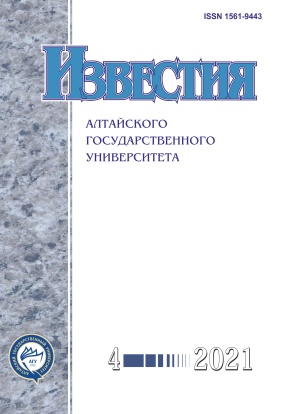Водная взвесь и ее влияние на суммарное ослабление света в озерной воде
УДК 53:556.55
DOI:
https://doi.org/10.14258/izvasu(2021)4-01Ключевые слова:
спектральный показатель ослабления света, счетная концентрация взвеси, метод оптической микроскопии, радиус частиц, озераАннотация
Материалы, использованные и представленные в данной работе, получены авторами в период 2012-2021 гг. в ходе полевых выездов на пресноводные водоемы Алтайского края. За исследуемый период, по данным гидрооптических измерений, значения показателя ослабления света в диапазоне 400-800 нм, рассчитанных при натуральном основании логарифма в поверхностном слое озер Лапа и Красиловское, варьировали в широких пределах 2,3-19,7 м-1 и 2,9-35,0 м-1 соответственно. Для оценки оптического влияния водной взвеси на суммарный показатель ослабления света рассчитан ее относительный спектральный вклад, а также вклад желтого вещества, хлорофилла и чистой воды на следующих длинах волн: 430, 550 и 670 нм. В результате расчетов получено, что в воде эвтрофного озера Лапа взвесь оказывает максимальное влияние на показатель ослабления света в осенне-зимний период. Осенью максимальный вклад взвеси наблюдался в 2015 г. (на всех трех длинах волн), достигая 88,5 %, минимальные вклады взвеси приходились на 2017 г.: 1,8-2,4 %. Для эвтрофно-гипер-эвтрофного озера Красиловское максимальные вклады взвеси в показатель ослабления света несколько более 70 % зафиксированы в 2014 г. зимой и весной — 71,3 % при λ=430 нм и 71,1 % при λ=550 нм соответственно.
Для определения размерного состава и счетной концентрации частиц водной взвеси использован метод оптической микроскопии. В результате получено, что средневзвешенный радиус частиц в поверхностном слое оз. Лапа за исследуемый период составил 1,2 мкм, в оз. Красиловское — 1,4 мкм. Среднее значение счетной концентрации частиц взвеси в озерах за период наблюдений изменялось в пределах от 0,2·106 см-3 до 14,7·106 см-3 и составило порядка 3,3·106 см-3 для оз. Лапа и 3,0·106 см-3 для оз. Красиловское.
Скачивания
Библиографические ссылки
Reinart A., Paavel B., Pierson D., Strombeck N. Inherent and apparent optical properties of Lake Peipsi, Estonia // Boreal Env. Res. 2004. № 9.
Mitchell B.G., Kahru M., Wieland J., Stramska М. Determination of spectral absorption coefficients of particles, dissolved material and phytoplankton for discrete water samples // Ocean Optics Protocols for Satellite. Ocean Color Sensor Validation. 2002. Revision 3. Vol. 2. Chapter 15.
Onderka M., Rodny M., Veliskova Y. Suspended particulate matter concentrations retrieved from self-calibrated multispectral satellite imagery // J. Hydrol. Hydromech. 2011. Vol. 59. № 4. DOI: 10.2478/v10098-011-0021-9.
Korosov A.A., Pozdnyakov D.V., Shuchman R., Sayers M., Sawtell R., Moiseev A.V Bio-optical retrieval algorithm for the optically shallow waters of Lake Michigan. I. Model description and sensitivity/robustness assessment // Transactions of KarRC RAS. 2017. № 3. DOI: 10.17076/lim473.
Shuchman R.A., Leshkevich G., Sayers M.J., Johengen T.H., Brooks C.N., Pozdnyakov D. An algorithm to retrieve chlorophyll, dissolved organic carbon, and suspended minerals from Great Lakes satellite data // J. Great Lakes Res. 2013. Vol. 32.
Churilova T.Ya., Moiseeva N.A., Latushkin А.А., Suslin V.V., Usoltseva M.V, Zakharova Yu.R., Titova L.A., Gnatovsky R.Yu., Blinov V.V. Preliminary results of bio-optical investigations at Lake Baikal // Limnol. and Freshwat. Biol. 2018. № 1. DOI:10.31951/2658-3518-2018-A-1-58.
Shi L., Mao Z., Wu J., Liu M., Zhang Y., Wang Z. Variations in spectral absorption properties of phytoplankton, non-algal particles and chromophoric dissolved organic matter in Lake Qiandaohu // Water. 2017. № 9. P 352. DOI:10.3390/w9050352.
Clavano W.R., Boss E., Karp-Boss L. Inherent optical properties of non-spherical Marine-like particles - from theory to observation // Oceanogr. and Marin. Biol.: An Ann. Rev. 2007. № 45.
Акулова О.Б. Разработка методов и измерительновычислительного комплекса для оценки экологически значимых гидрооптических характеристик пресноводных водоемов (на примере озер Алтайского края) : Дис. ... канд. тех. наук. Барнаул, 2015.
Копелевич О.В. Малопараметрическая модель оптических свойств морской воды // Оптика океана. Т. 1. Физическая оптика океана / Под ред. А.С. Монина. М., 1983.
Pope R.M., Fry E.S. Absorption spectrum (380-700 nm) of pure water. II. Integrating cavity measurements // Applied Optics., 1997. Vol. 36. № 33.
Smith R.C., Baker K.S. Optical properties of the clearest natural waters (200-800 nm) // Applied Optics. 1981. Vol. 20. № 2.
Загрузки
Опубликован
Выпуск
Раздел
Лицензия
Izvestiya of Altai State University is a golden publisher, as we allow self-archiving, but most importantly we are fully transparent about your rights.
Authors may present and discuss their findings ahead of publication: at biological or scientific conferences, on preprint servers, in public databases, and in blogs, wikis, tweets, and other informal communication channels.
Izvestiya of Altai State University allows authors to deposit manuscripts (currently under review or those for intended submission to Izvestiya of Altai State University) in non-commercial, pre-print servers such as ArXiv.
Authors who publish with this journal agree to the following terms:
- Authors retain copyright and grant the journal right of first publication with the work simultaneously licensed under a Creative Commons Attribution License (CC BY 4.0) that allows others to share the work with an acknowledgement of the work's authorship and initial publication in this journal.
- Authors are able to enter into separate, additional contractual arrangements for the non-exclusive distribution of the journal's published version of the work (e.g., post it to an institutional repository or publish it in a book), with an acknowledgement of its initial publication in this journal.
- Authors are permitted and encouraged to post their work online (e.g., in institutional repositories or on their website) prior to and during the submission process, as it can lead to productive exchanges, as well as earlier and greater citation of published work (See The Effect of Open Access).








